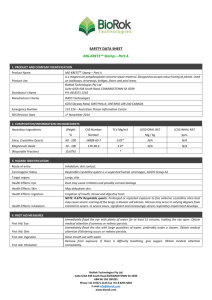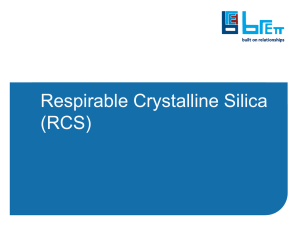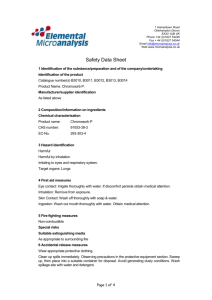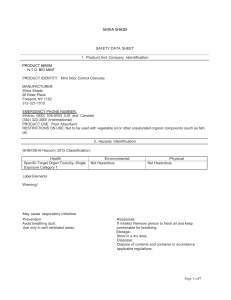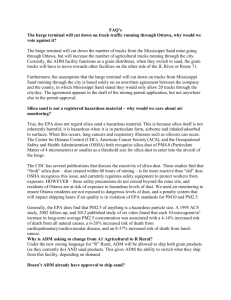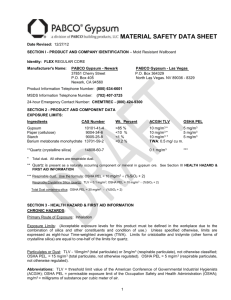Material Data Safety Sheet
advertisement
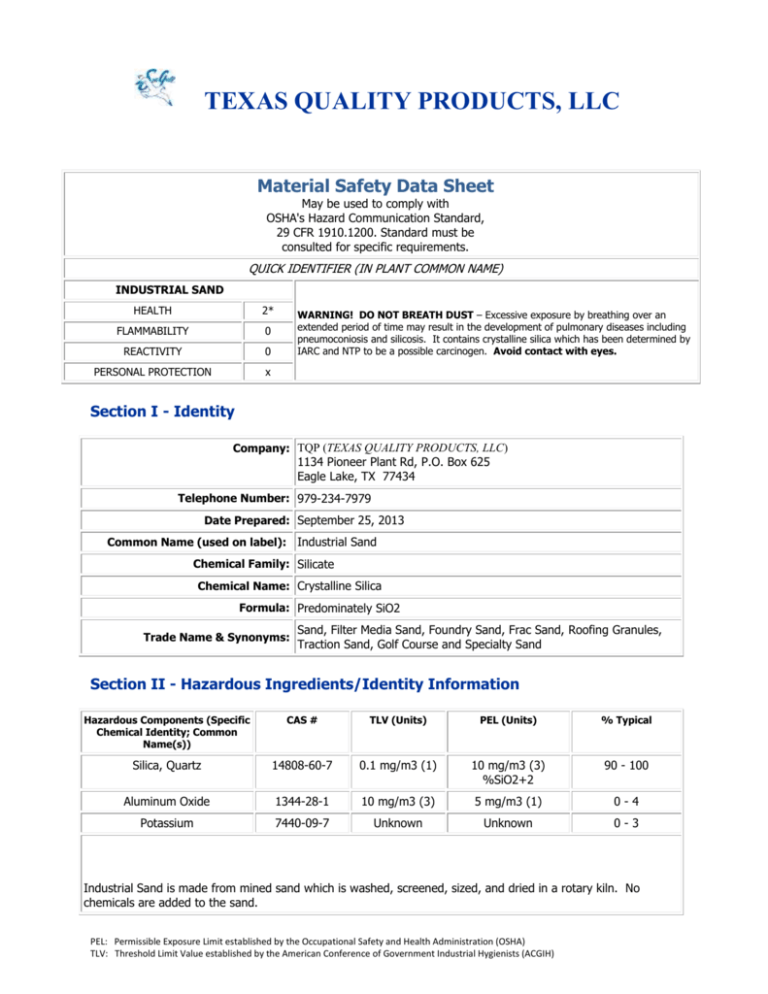
TEXAS QUALITY PRODUCTS, LLC Material Safety Data Sheet May be used to comply with OSHA's Hazard Communication Standard, 29 CFR 1910.1200. Standard must be consulted for specific requirements. QUICK IDENTIFIER (IN PLANT COMMON NAME) INDUSTRIAL SAND HEALTH 2* FLAMMABILITY 0 REACTIVITY 0 PERSONAL PROTECTION x WARNING! DO NOT BREATH DUST – Excessive exposure by breathing over an extended period of time may result in the development of pulmonary diseases including pneumoconiosis and silicosis. It contains crystalline silica which has been determined by IARC and NTP to be a possible carcinogen. Avoid contact with eyes. Section I - Identity Company: TQP (TEXAS QUALITY PRODUCTS, LLC) 1134 Pioneer Plant Rd, P.O. Box 625 Eagle Lake, TX 77434 Telephone Number: 979-234-7979 Date Prepared: September 25, 2013 Common Name (used on label): Industrial Sand Chemical Family: Silicate Chemical Name: Crystalline Silica Formula: Predominately SiO2 Trade Name & Synonyms: Sand, Filter Media Sand, Foundry Sand, Frac Sand, Roofing Granules, Traction Sand, Golf Course and Specialty Sand Section II - Hazardous Ingredients/Identity Information Hazardous Components (Specific Chemical Identity; Common Name(s)) CAS # TLV (Units) PEL (Units) % Typical Silica, Quartz 14808-60-7 0.1 mg/m3 (1) 10 mg/m3 (3) %SiO2+2 90 - 100 Aluminum Oxide 1344-28-1 10 mg/m3 (3) 5 mg/m3 (1) 0-4 Potassium 7440-09-7 Unknown Unknown 0-3 Industrial Sand is made from mined sand which is washed, screened, sized, and dried in a rotary kiln. No chemicals are added to the sand. PEL: Permissible Exposure Limit established by the Occupational Safety and Health Administration (OSHA) TLV: Threshold Limit Value established by the American Conference of Government Industrial Hygienists (ACGIH) (1) Only particle sizes of 10 micrometers of less are considered to be respirable (breathable) and of possible hazard if exposure occurs. (2) The percentage of crystalline silica in the formula is the amount determined from airborne samples, except in those instances in which other methods have been shown to be applicable. (3) For total dust (nuisance particulate) containing no asbestos and <1% crystalline silica. (4) This is an impurity in the sand particle. It is not similar in metallic forms. Section III - Physical/Chemical Characteristics Boiling Point Specific Gravity (H2O = 1) Does not apply 2.63 – 2.67 Vapor Pressure (mm Hg) Melting Point Does not apply Does not apply Vapor Density (AIR = 1) Evaporation Rate Does not apply (Butyl Acetate = 1) Does not apply Solubility in Water Not soluble Appearance and Odor Fine to coarse granular solid with glassy, crystalline structure. Sub-round to round particles. Mesh sizes vary depending on the gradation required. Off-white to white in color. No odor. Section IV - Fire and Explosion Hazard Data Flash Point (Method Used) Flammable Limits LEL UEL Will not ignite N/A N/A N/A Extinguishing Media None Required Special Fire Fighting Procedures None Auto Ignition Temperature Does Not Apply Unusual Fire and Explosion Hazards None Section V - Reactivity Data Stability Unstable Stable N/A Conditions to Avoid Does not apply Incompatibility (Materials to Avoid) None determined Hazardous Decomposition or Byproducts None Hazardous Polymerization: May Occur Will Not Occur TQP092012 Conditions to Avoid Shattering of sand particles such as in sand blasting operations may produce a dust with a high percentage of silica. Section VI - Health Hazard Data Route(s) of Entry: Inhalation? Skin? Ingestion? Yes N/A N/A Health Hazards (Acute and Chronic): Acute Overexposure: This is exposure of large amounts in a short period of time: Inhalation of dust may result in blockage of nasal and respiratory passages. See Section 8 for Recommended respiratory protection. Chronic Overexposure: This is exposure of small to moderate amounts over a long period of time: As is true with any mineral product, long term overexposure to this dust without the use of proper respiratory protection may produce x-ray evidence of dust in the lungs. Dust can cause inflammation of the lining tissue of the nose and inflammation of the eyes. Long term exposure to quartz may result in the development of pulmonary diseases including pneumoconiosis, silicosis, and possibly cancer. Some epidemiological studies have found limited evidence of lung cancer in humans exposed to quartz dust. See Section 8 for recommended respiratory protection. Carcinogenicity: Quartz NTP? IARC? OSHA Regulated? Yes Yes No Signs and Symptoms of Exposure Inhaling respirable dust and/or crystalline silica may aggravate existing respiratory system disease(s) and/or dysfunctions. Exposure to dust may aggravate existing skin and/or eye conditions. Medical Conditions Generally Aggravated by Exposure Respiratory (lung) disorders or diseases may be aggravated by exposure to dust. Emergency and First Aid Procedures EYES: Do Not Rub Eyes! Immediately flush eye(s) with plenty of clean water for at least 15 minutes, while holding eyelid(s) open. Occasionally lift the eyelid(s) to ensure thorough rinsing. Beyond flushing, do not attempt to remove material from the eye(s). Obtain medical assistance, if irritation persists or later develops. SKIN: Wash with soap and water. INGESTION: If person is conscious, give large quantity of water and induce vomiting; however, never attempt to make an Unconscious person drink or vomit. Get immediate medical attention. INHALATION: Remove to fresh air. Dust in throat and nasal passages should clear spontaneously. If breathing is difficult, give oxygen. Obtain medical assistance, if irritation persists or later develops. Section VII - Precautions for Safe Handling and Use Steps to Be Taken in Case Material is Released or Spilled: Clean-up of spill may require personal protective equipment to prevent dust exposures. See Section 8. Waste Disposal Method TQP092012 If this material, as provided by the manufacturer, becomes a waste, it does not meet the criteria of a hazardous waste as defined by the Environmental Protection Agency under the authority of the Resource Conservation and Recovery Act (40 CFR 261). Dispose of in accordance with Federal, state and local regulations. Precautions to Be taken in Handling and Storing Should be stored in a manner to prevent the generation or accumulation of dust. Do not use dry sweeping or compressed air for removal of dust. If vacuuming is used, the exhaust air should be properly filtered. Use water to clean surfaces if practical. Excessive handling of sand in a manner that causes the sand particles to abrade one another (rub together) may produce a dust with an increase in the percentage of respirable silica. Other Precautions Refer to Occupational Safety and Health Administration Standards 29 CFR Section 1910.134 which includes guidelines for personal protection for occupational exposure to dusts, including those containing crystalline silica. Where exposure to airborne silica is above the PEL, work clothing should be vacuumed before removal. Do not shake or blow dust from clothing. Section VIII - Control Measures Respiratory Protection (Specify Type): Local Exhaust Ventilation Other Yes Maintain exposure below TLV/PEL. Ventilation should be designed and maintained to prevent the accumulation or recirculation of airborne silica dust into the workplace. If employee is above PEL, the employer is required to implement engineering and administrative controls. If these controls are not adequate, respirators for protection against silica and nuisance dust should be used as required in 29 CFR 1910.134. Mechanical (General) Protective Gloves Yes To protect against abrasion. Other Protective Clothing or Equipment Eye Protection A vacuum should be used to remove dust from clothing or other surfaces. Safety glasses, goggles, or face shield, when necessary to prevent eye contact. Work/Hygienic Practices Wash dust-exposed skin regularly and clothing after every use. * U.S.G.P.O.: 1986 - 491 - 529/45775 TQP092012
